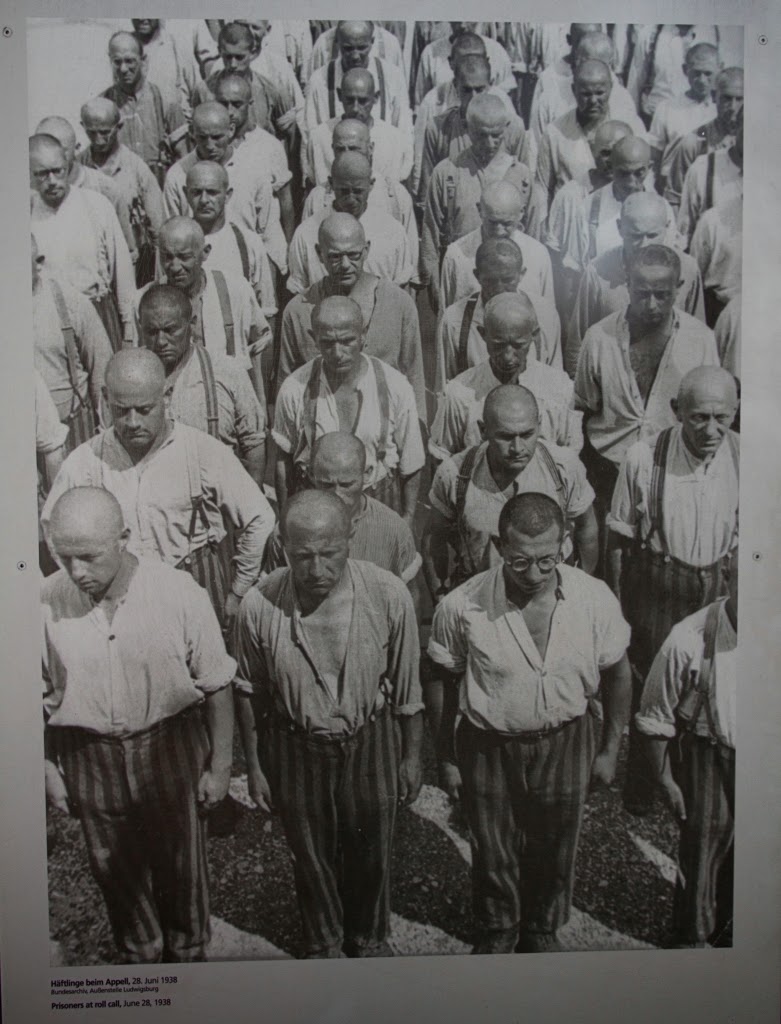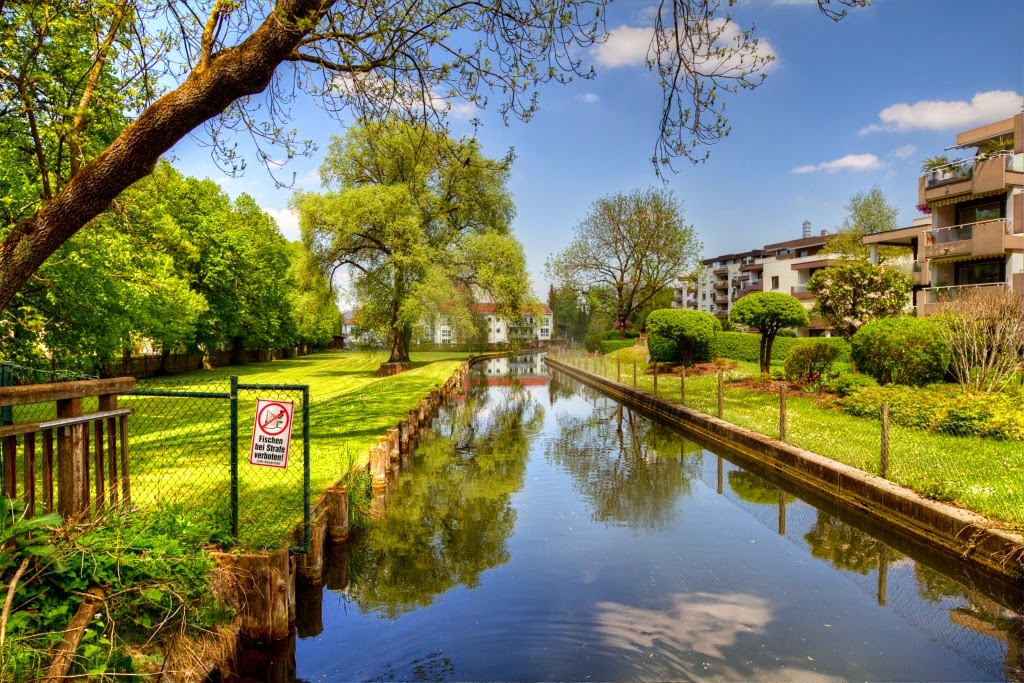My last day in Munich. Michelle’s
knee was totally stuffed, so I went to Dachau on my own. Tim helped me with
working out the transport – S8 to Liem, S2 to Dachau, Bus to the Camp. It was
really simple and the bus to the concentration camp was waiting at the station
when I got off the train.
It was really hard to see Dachau as
the terrible camp it was. That was because it was a bright sunny spring day.
The birds were singing loudly, all the new green leaves were on the trees, and
it was in a truly beautiful setting. I think the best time to visit would be
winter, when one can imagine how cold it would have been for the prisoners and
the landscape would be stark.
The camp is free for visitors, so I
decided to check out the audio-guide option – hoping it would be compatible
with my implant – and it was! I was really surprised – first time ever! I
rented the guide for 3 euros 50 and for the first time was able to hear
everything and understand everything. I spent about 3 hours wandering around
listening to the informative guide, and was really shocked to find out that
Jews were sent to the camps as early as 1933. I had thought it was only for the
duration of the war – from 1939 to 1945. A couple of times I wondered why I
couldn't hear anything, to find I had clicked on an account of the camp that was
actually in German or Dutch!
After wandering down the tree lined
avenue you enter Dachau Concentration Camp through gatehouse that was built in
1936.
Newly arriving prisoners were
forced through this gate with the inscription ‘Work Brings Freedom’.
Located in this gatehouse were the
interrogation rooms of the Political Dept/Gestapo and the offices of the block
and report leaders. Prisoners accused by the SS of violating camp rules were
interrogated and sentence to corporeal punishment or torture. The prisoners
therefore consider the gatehouse (jourhaus) to be the centre of SS Rule over
the camp.
The roll call area
was huge. The prisoners had to assemble here every morning and evening for roll
call. In all weather conditions
they had to stand to attention motionless for about an hour. Sometimes even the
dead had to be dragged to the roll call ground to be counted. If the number of
prisoners didn't match the official head count, then the torture could last for
many hours. Sick and weak prisoners often collapsed but other prisoners were
forbidden to help. The SS often carried out punishments for all prisoners to
see. Many sick/exhausted people died on this ground.
 |
| Add caption |
The Maintenance
building was built by the Prisoners in 1937-1938. It served the needs of the
prisoners in the camp, and housed a kitchen, laundry, and workshops. Today it
serves as the museum for visiting tourists. It also has a memorial room with
plaques and books in memory of those who died.
Looking towards the Maintenance
building from the Barracks. I have to say I visited the public restrooms in the
Maintenance Building. The smell was terrible. So bad I had to hold my nose.
They looked clean, so I wondered if the smell is just left over from camp days,
and if so, then I had no right to complain if that was all I had to suffer in
the short time I was in there!
The Memorial Room...
The perimeter fence surrounded the
camp and was built and designed to make escape impossible. SS men kept watch
from seven towers in the camp. The minute a prisoner entered the prohibited
zone, they were fired upon. Some prisoners ran to the border strip on purpose
to put an end to their suffering.
This part of the Perimeter fence
had a moat, then a barbed wire fence, and where the trees were was also a
river. So it was really difficult for any escape to be successful.
During the new construction of the
camp, the prisoners had to build 34 barracks. Every barrack was divided into
four rooms, comprising of a day room and a dormitory. Each barrack was fitted
to hold 200 men, however towards the end of the war they were completely
overfilled, and holding up to 2000 prisoners in each.
Most of the barracks were
dismantled but each row would have had barracks in a line like the black and
white photo below..
The tree lined
'avenue' was beautiful, and like I said before, it was hard to believe that it
was a place of so much human suffering.
Bouquets of flowers
in remembrance were placed on various rows of barracks.
The Crematorium was
built in the summer of 1940 after the foreign prisoners arrived and the
mortality rate greatly increased. A year later it was working beyond capacity,
and another bigger crematorium with more ovens was nearby. This particular one
was in operation until 1943. During this period nearly 11,000 prisoners were
cremated here.
In the same complex of the new
crematorium, several other rooms were built. The Waiting room, where prisoners
were to be gathered and informed about the ‘showers’ they were about to go into.
The Gas Chamber
which was supposedly never used. The room was disguised as ‘showers’ and
equipped with fake shower spouts to mislead the prisoners and prevent them from
refusing to enter the room. During a period of 15-20 minutes, up to 150 people
at a time could be suffocated to death through poison gas (Zyklon B).
I was rather chilled to be standing
in this room. I also am left wondering about the information that it was ‘never
used’. Why build it if not to be used? The prisoners aren’t likely to know if
the room was used or not, and the camp leaders/gestapo aren’t likely to own up
to it either! Big question mark here for me!
The Death chamber
where the dead were brought before they were cremated.
And finally the new
Crematorium or ‘incinerator room’. Each of the four furnaces could cremate 2-3
corpses at once. The ovens were connected to the chimneys by an underground
canal. In front of the ovens is the execution site. Most hangings were carried
out directly in front of the ovens.
After I dropped back the audio-guide, I waited for the bus to take me back to the train station. The amount of pollen in the air was incredible - never seen anything like it. If you look carefully you'll see white stuff floating in the air!
Back at the
station, I decided to walk around the Dachau town centre itself, armed with a
shopping list for my friend Viola back home. I managed to get everything on her
list, although had to go to several shops to find them all as some didn't stock
the brands she wanted. Everyone was helpful, and most amused when I bought six
tins of cough lozenges for export to NZ! Dachau itself was really
beautiful. Like Ismaning where I was staying, there are trout in these
beautiful clear, clean canals.
I did wonder though, how the
residents of Dachau didn't know what was going on over at the nearby camp. Or
if they did, were they powerless to prevent it or speak out? I had so much going
on in my mind. Every town here has so many churches – why didn't the church
step in and prevent what was happening?
I walked back to bus station and
made my way back to Ismaning where Michelle made a late lunch, early dinner – a
beautiful healthy smoothie and a gorgeous meal. I think I’ll have to come and
live with her in Munich she’s such a great cook.
Afterwards we all went for a walk with my
luggage to the park next to the train station and sat and talked and watched
Ayla play and run around. Made me realise that life goes on, always renewing no
matter how bad situations get. I just wish History wouldn't repeat! Ayla is
gorgeous - such a busy wee tot!
I then got on the train and headed to the airport to catch my
plane to Thessaloniki to meet up with Vivie and my daughter for the next part
of our travels. This image was taken from the train, and is so typical of the
Munich countryside I saw. Colourful, lush, clean, beautiful.
I had arrived in Germany prepared to
dislike the country immensely due to what happened in WWII. But I was
pleasantly surprised that it was so beautiful. Everything ran like a well oiled
machine. People were friendly and helpful and I enjoyed my stay immensely.
I’m glad I went to Dachau though.
Lest we Forget.

































3 comments:
And yes, everyone's friendly now. And of course they knew what was going on. I've read you could smell the crematoria for miles. They knew. So did the churches. Some protected Jews, but not enough did.
Robin,
As a Jew, I found this post interesting, disturbing, and sad. I am very lucky that my family was already in North America during this horrible time, so I did not lose any relatives in the camps. But that doesn't really make it any easier. Thank you for sharing.
Leona
While I was living in Germany in the 1980's, I went to Dachau. I cried. I asked the same question as you, how come the neighbors didn't know. I was told that they heard the singing of the inmates, not knowing it was a coping mechanism for them. It was a factory, and with factories in those days pollution and odors were the norm. They did not know what was really going on. Also, they told us birds still did not fly over the compound. I did not see any living creatures in it..just us humans. I was overwhelmed with grief and sadness and I could not finish the tour. I had to find a place to sit and and mourn. I was saddened for weeks after going to Dachau.
Post a Comment